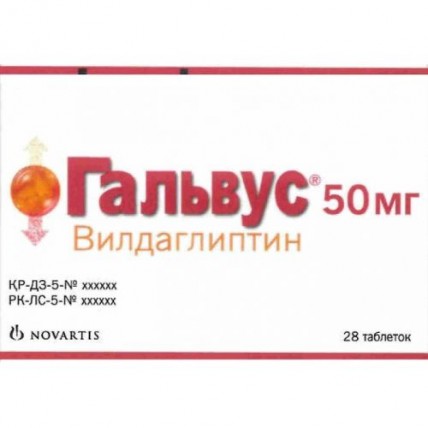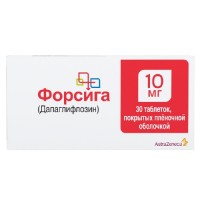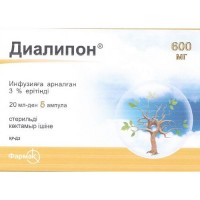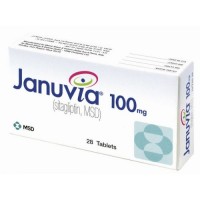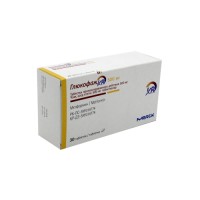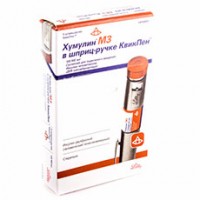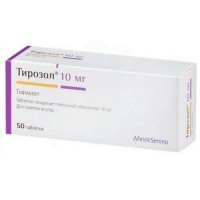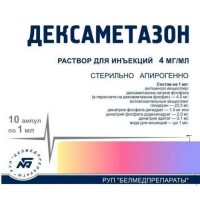Galvus® (Vildagliptin) 50 mg, 28 tablets
- $29.70
Galvus (Vildagliptin) is a relatively recently approved oral treatment for people with type 2 diabetes. Galvus is often taken in conjunction with other anti-diabetes medications such as metformin, sulphonylureas and thiazolidinediones. Galvus was proven in clinical trials to add efficiency when used in combination with other anti-diabetic medication. Galvus clinical trials before approval included some 20,000 patients. The diabetes drug was found to reduce blood sugar significantly.
One tablet contains the active substance vildagliptin 50 mg
Type 2 diabetes mellitus:
as monotherapy in combination with diet and exercise, as well as in patients with contraindications to metformin therapy or intolerance;
as part of a two-component combination therapy:
with metformin in patients with insufficient glycemic control, despite the maximum tolerated dose with metformin monotherapy,
with sulfonylurea in patients with insufficient glycemic control, despite the maximum tolerated dose with metformin monotherapy and in patients with contraindications to metformin therapy or intolerance,
with thiazolidinedione in patients with insufficient glycemic control and in patients for whom thiazolidinedione therapy is suitable;
as part of a three-component combination therapy with sulfonylurea and metformin, when diet, exercise, and two-component therapy do not lead to the achievement of adequate glycemic control;
in combination with insulin (with or without metformin) when diet, exercise, and a stable dose of insulin do not achieve adequate glycemic control.
Adult patients
Galvus® is taken orally, regardless of food intake.
The recommended dose of the drug during monotherapy or as part of a two-component combination therapy with metformin, thiazolidinedione or as part of a three-component combination therapy with sulfonylurea and metformin or in combination with insulin is 100 mg per day, applied at 50 mg in the morning and 50 mg in the evening.
As part of a two-component combination therapy with sulfonylurea, the recommended dose of Galvus® is 50 mg once a day in the morning. In this group of patients, the dose of 100 mg per day was not more effective than the dose of 50 mg per day.
When used in combination with sulfonylurea, a dose reduction of the sulfonylurea should be considered to reduce the risk of hypoglycemia.
Doses in excess of 100 mg are not recommended.
If the patient has not taken the dose on time, Galvus® should be taken as soon as the patient remembers it. Do not use a double dose on the same day.
The safety and efficacy of vildagliptin as part of a triple combination therapy with metformin and thiazolidinedione has not been established.
Additional information on special patient groups
Elderly patients (≥ 65 years)
When prescribing the drug to elderly patients, dose adjustment is not required.
Patients with impaired renal function
No dose adjustment is required when prescribing the drug to patients with an initial stage of renal failure (with creatinine clearance ≥ 50 ml / min). In patients with moderate or severe renal failure or end-stage renal disease, the recommended dose of Galvus® is 50 mg once a day.
Patients with impaired liver function
The drug Galvus® should not be prescribed to patients with impaired liver function, including patients previously undergoing treatment, with increased activity of alanine aminotransferase (ALT) or aspartate aminotransferase (AST)> 3 times compared with the upper limit of normal (ULN).
Children and adolescents up to 18 years old
It is not recommended to prescribe the drug to children and adolescents under 18 years of age. There are no data on the efficacy and safety of Galvus® in children and adolescents under the age of 18 years.
When using the drug Galvus® as monotherapy or in combination with other drugs, most of the adverse reactions were mild, were temporary and did not require discontinuation of therapy. There was no correlation between the incidence of adverse events and age, sex, ethnicity, duration of use or dosage regimen.
The following adverse reactions are classified by frequency of occurrence, with the most common listed first.
When using the drug Galvus® as monotherapy
When using the drug Galvus® at a dose of 50 mg 1 time / day or 2 times / day, the frequency of discontinuation of therapy due to the development of adverse reactions (0.2% or 0.1%, respectively) was not higher than that in the placebo group (0.6%) or the reference drug ( 0.5%).
Against the background of monotherapy with Galvus® at a dose of 50 mg 1 time / day or 2 times / day, the incidence of hypoglycemia without increasing the severity of the condition was 0.5% (2 people out of 409) or 0.3% (4 out of 1082), which is comparable to the drug comparison and placebo (0.2%). When using the drug Galvus® in the form of monotherapy, there was no increase in the patient's body weight.
Often (> 1/100, <1/10)
dizziness
Uncommon (> 1/1000, <1/100)
headache
constipation
peripheral edema
hypoglycemia
joint pain
Very rare (<1/10,000)
upper respiratory tract infections
nasopharyngitis
When using the drug Galvus® at a dose of 100 mg 1 time / day or 2 times / day in combination with metformin
When using the drug Galvus® at a dose of 100 mg / day in combination with metformin, the frequency of discontinuation of therapy due to the development of adverse reactions was 0.4% (in the groups vildagliptin (50 mg 2 times / day) + metformin and placebo + metformin, cases of discontinuation of therapy due to with the development of undesirable reactions was not noted).
When using the drug Galvus® at a dose of 50 mg 1 time / day or 2 times / day in combination with metformin, hypoglycemia was observed in 0.9% and 0.5% of cases, respectively (in the placebo + metformin group - 0.4%). The development of severe hypoglycemia was not observed in the Galvus® group. The combination therapy vildagliptin + metformin did not affect the body weight of the patients.
Often (> 1/100, <1/10)
hypoglycemia
tremor
headache
dizziness
Uncommon (> 1/1000, <1/100)
feeling tired
When using the drug Galvus® at a dose of 50 mg / day in combination with sulfonylurea derivatives
When using the drug Galvus® at a dose of 50 mg / day in combination with glimepiride, the frequency of discontinuation of therapy due to the development of adverse reactions was 0.6% (compared to 0% in the glimepiride + placebo group).
The incidence of hypoglycemia in patients who received Galvus® at a dose of 50 mg / day together with glimepiride was 1.2% (compared to 0.6% in the placebo + glimepiride group). The development of severe hypoglycemia was not observed in the Galvus® group.
When using the drug Galvus® in the recommended dose (50 mg / day) in combination with glimepiride, there was no increase in the patient's body weight.
Often (> 1/100, <1/10)
headache
dizziness
weakness
tremor
hypoglycemia
Uncommon (> 1/1000, <1/100)
constipation
Very rare (<1/10,000)
nasopharyngitis
When using the drug Galvus® at a dose of 50 mg 1 time / day or 2 times / day in combination with thiazolidinedione derivatives
When using the drug Galvus® at a dose of 50 mg / day in combination with pioglitazone, the frequency of discontinuation of therapy due to the development of adverse reactions was 0.7% (in the groups vildagliptin (50 mg 2 times / day) + pioglitazone and placebo + pioglitazone cases of discontinuation of therapy due to with the development of undesirable reactions was not noted).
When using the drug Galvus® at a dose of 50 mg / day in combination with pioglitazone at a dose of 45 mg, hypoglycemia was not observed; in the group vildagliptin (at a dose of 50 mg 2 times / day) + pioglitazone (at a dose of 45 mg) hypoglycemia was noted in 0.6% of cases, and in patients receiving placebo + pioglitazone at a dose of 45 mg - in 1.9% of cases. The development of severe hypoglycemia was not observed in the Galvus® group. The average increase in body weight compared with placebo in patients receiving Galvus® at a dose of 50 mg 1 time / day or 2 times / day together with pioglitazone was + 0.1 kg or +1.3 kg, respectively.
When Galvus® was added at a dose of 50 mg 1 time / day or 2 times / day to pioglitazone at a dose of 45 mg / day, the incidence of peripheral edema was 8.2% and 7%, respectively (compared to 2.5% with pioglitazone monotherapy). However, with the appointment of the initial combination therapy with vildagliptin at a dose of 50 mg 1 time / day or 2 times / day together with pioglitazone at a dose of 45 mg / day, peripheral edema was observed in 3.5% or 6.1% of patients, respectively (compared with 9.3% during monotherapy with pioglitazone at a dose of 30 mg / day).
Often (> 1/100, <1/10)
weight gain
peripheral edema
Uncommon (> 1/1000, <1/100)
headache
weakness
hypoglycemia
When using the drug Galvus® at a dose of 50 mg 2 times / day in combination with insulin
When the drug was prescribed in combination with insulin, there was no increase in the risk of hypoglycemia compared with the combination of placebo + insulin.
The average increase in body weight compared with placebo in patients receiving Galvus® at a dose of 50 mg 2 times / day together with insulin was +0.6 kg.
Often (> 1/100, <1/10)
headache
nausea, gastroesophageal reflux disease
chills
lowering blood glucose
Uncommon (> 1/1000, <1/100)
diarrhea, flatulence
Combination with metformin and sulfonylurea
Often (> 1/100, <1/10)
dizziness, tremors
asthenia
hypoglycemia
hyperhidrosis
Post-marketing studies (frequency unknown): during post-marketing studies and screening of the literature, the following adverse reactions were identified: hepatitis, liver dysfunction (reversible upon discontinuation of therapy), urticaria, pancreatitis, bullous and exfoliative skin lesions.
hypersensitivity to vildagliptin or to any of the excipients
Galvus® has a low potential for drug interactions. Since Galvus® is not a substrate for cytochrome P (CYP) 450 enzymes, nor does it inhibit or induce CYP 450 enzymes, the interaction of Galvus® with other drugs that are substrates, inhibitors or inducers of this enzyme system is unlikely.
With the simultaneous use of vildagliptin also does not affect the metabolic rate of drugs that are enzyme substrates: CYP1A2, CYP2C8, CYP2C9, CYP2C19, CYP2D6, CYP2E1 and CYP3A4 / 5. Studies have been carried out on the interaction of vildagliptin with drugs often prescribed in combination for type 2 diabetes mellitus, as well as with drugs having a narrow therapeutic range.
No clinically significant interaction of Galvus® with drugs most commonly used in the treatment of type 2 diabetes mellitus (glibenclamide, pioglitazone, metformin) or those with a narrow therapeutic range (amlodipine, digoxin, ramipril, simvastatin, valsartan, warfarin) has not been established.
As with other oral antidiabetic drugs, the hypoglycemic effect of vildagliptin may be reduced when used with certain drugs, including thiazides, corticosteroids, thyroid drugs, and sympathomimetics.
If insulin therapy is required, Galvus® is used only in combination with insulin. The drug should not be used in patients with type 1 diabetes mellitus or for the treatment of diabetic ketoacidosis.
Renal dysfunction
The experience of use in patients with end-stage renal failure undergoing hemodalysis is limited. Therefore, Galvus® should be used with caution in these patients.
Liver dysfunction
Galvus® is not recommended for patients with impaired liver function, including patients with baseline ALT or AST values> 3 times the upper limit of normal before starting therapy.
Monitoring liver enzymes
There have been rare reports of symptoms of hepatic dysfunction (including hepatitis), which were usually asymptomatic and had no clinical consequences. Studies have shown that liver function returns to normal after stopping therapy. Before starting treatment with Galvus®, it is necessary to check the liver function in order to know the initial values. During treatment with Galvus®, liver function should be monitored every three months during the first year and periodically checked thereafter. If the patient has an increased activity of aminotransferases, this result should be confirmed by a second study, and then regularly determine the biochemical parameters of liver function until they are normalized. If the activity of AST or ALT is 3 times or more higher than the upper limit of the norm, the drug is recommended to be canceled.
With the development of jaundice or other signs of liver dysfunction while using Galvus®, drug therapy should be stopped immediately. After normalization of liver function indicators, drug treatment cannot be resumed.
Heart failure
A clinical study of vildagliptin in patients with NYHA functional class I-III showed that vildagliptin therapy did not affect left ventricular function or worsening pre-existing congestive heart failure compared with placebo. Clinical experience in NYHA functional class III patients treated with vildagliptin is limited and there are no definitive results.
There is no experience of using vildagliptin in clinical trials in patients with NYHA functional class IV and, therefore, its use in these patients is not recommended.
Skin lesions
Skin lesions including blisters and ulcers have been reported in monkey limbs during preclinical toxicology studies. Although there has been no increase in skin lesions in clinical trials, there is limited experience with the treatment of diabetic skin patients. In addition, in the post-marketing period, there were reports of the occurrence of bullous and exfoliative skin lesions. Therefore, when prescribing the drug to patients with diabetes, it is recommended to monitor for the presence of skin abnormalities such as blisters or ulcers.
Acute pancreatitis
The use of vildagliptin is associated with the risk of developing acute pancreatitis.
Patients should be informed about the characteristic symptoms of acute pancreatitis.
If there is a suspicion of pancreatitis, the use of the drug should be discontinued, if pancreatitis is confirmed, then therapy with Galvus® should not be resumed. Care must be taken when using the drug in patients with a history of acute pancreatitis.
Hypoglycemia
Sulfonylurea is known to cause hypoglycemia. Patients taking vildagliptin in combination with sulfonylurea are at risk of developing hypoglycemia. A dose reduction of sulfonylurea may be required to reduce the risk of hypoglycemia.
Excipients
The tablets contain lactose. Patients with hereditary fructose intolerance, Lapp lactase deficiency, glucose-galactose malabsorption should not use Galvus®.
Pregnancy and the period of breastfeeding
there are no on-site data on the use of Galvus® in pregnant women. Animal studies have shown reproductive toxicity with high doses of the drug. The potential risk to humans is unknown. Due to the lack of data on human exposure, the drug should not be used during pregnancy.
It is not known whether vildagliptin is excreted in breast milk. Animal studies have shown the release of vildagliptin into milk. Galvus® should not be used during breastfeeding.
Fertility
Studies on the effect of Galvus® on fertility have not been conducted.
Features of the effect of the drug on the ability to drive vehicles or other potentially dangerous mechanisms
Studies on the effect of Galvus® on the ability to drive vehicles or other mechanisms have not been conducted. With the development of dizziness during treatment with the drug, patients should not drive vehicles or work with mechanisms.
Symptoms: when using the drug at a dose of 400 mg / day, muscle pain may be observed; rarely - light and transient paresthesias, fever, edema, and a transient increase in lipase concentration (2 times higher than VGN). With an increase in the dose of Galvus® to 600 mg / day, edema of the extremities with paresthesias and an increase in the concentration of CPK, ALT, C-reactive protein and myoglobin are possible. All overdose symptoms and changes in laboratory parameters disappear after discontinuation of the drug.
Treatment: elimination of the drug from the body using hemodialysis is unlikely. However, the major hydrolytic metabolite of vildagliptin (LAY151) can be removed from the body by hemodialysis.
Store at a temperature not exceeding 30 С. Protect from moisture.
Keep out of the reach of children!
Shelf life - 3 years
The drug should not be used after the period indicated on the package.
Structure
One tablet contains the active substance vildagliptin 50 mg
Indications for use
Type 2 diabetes mellitus:
as monotherapy in combination with diet and exercise, as well as in patients with contraindications to metformin therapy or intolerance;
as part of a two-component combination therapy:
with metformin in patients with insufficient glycemic control, despite the maximum tolerated dose with metformin monotherapy,
with sulfonylurea in patients with insufficient glycemic control, despite the maximum tolerated dose with metformin monotherapy and in patients with contraindications to metformin therapy or intolerance,
with thiazolidinedione in patients with insufficient glycemic control and in patients for whom thiazolidinedione therapy is suitable;
as part of a three-component combination therapy with sulfonylurea and metformin, when diet, exercise, and two-component therapy do not lead to the achievement of adequate glycemic control;
in combination with insulin (with or without metformin) when diet, exercise, and a stable dose of insulin do not achieve adequate glycemic control.
Method of administration and dosage
Adult patients
Galvus® is taken orally, regardless of food intake.
The recommended dose of the drug during monotherapy or as part of a two-component combination therapy with metformin, thiazolidinedione or as part of a three-component combination therapy with sulfonylurea and metformin or in combination with insulin is 100 mg per day, applied at 50 mg in the morning and 50 mg in the evening.
As part of a two-component combination therapy with sulfonylurea, the recommended dose of Galvus® is 50 mg once a day in the morning. In this group of patients, the dose of 100 mg per day was not more effective than the dose of 50 mg per day.
When used in combination with sulfonylurea, a dose reduction of the sulfonylurea should be considered to reduce the risk of hypoglycemia.
Doses in excess of 100 mg are not recommended.
If the patient has not taken the dose on time, Galvus® should be taken as soon as the patient remembers it. Do not use a double dose on the same day.
The safety and efficacy of vildagliptin as part of a triple combination therapy with metformin and thiazolidinedione has not been established.
Additional information on special patient groups
Elderly patients (≥ 65 years)
When prescribing the drug to elderly patients, dose adjustment is not required.
Patients with impaired renal function
No dose adjustment is required when prescribing the drug to patients with an initial stage of renal failure (with creatinine clearance ≥ 50 ml / min). In patients with moderate or severe renal failure or end-stage renal disease, the recommended dose of Galvus® is 50 mg once a day.
Patients with impaired liver function
The drug Galvus® should not be prescribed to patients with impaired liver function, including patients previously undergoing treatment, with increased activity of alanine aminotransferase (ALT) or aspartate aminotransferase (AST)> 3 times compared with the upper limit of normal (ULN).
Children and adolescents up to 18 years old
It is not recommended to prescribe the drug to children and adolescents under 18 years of age. There are no data on the efficacy and safety of Galvus® in children and adolescents under the age of 18 years.
Side effects
When using the drug Galvus® as monotherapy or in combination with other drugs, most of the adverse reactions were mild, were temporary and did not require discontinuation of therapy. There was no correlation between the incidence of adverse events and age, sex, ethnicity, duration of use or dosage regimen.
The following adverse reactions are classified by frequency of occurrence, with the most common listed first.
When using the drug Galvus® as monotherapy
When using the drug Galvus® at a dose of 50 mg 1 time / day or 2 times / day, the frequency of discontinuation of therapy due to the development of adverse reactions (0.2% or 0.1%, respectively) was not higher than that in the placebo group (0.6%) or the reference drug ( 0.5%).
Against the background of monotherapy with Galvus® at a dose of 50 mg 1 time / day or 2 times / day, the incidence of hypoglycemia without increasing the severity of the condition was 0.5% (2 people out of 409) or 0.3% (4 out of 1082), which is comparable to the drug comparison and placebo (0.2%). When using the drug Galvus® in the form of monotherapy, there was no increase in the patient's body weight.
Often (> 1/100, <1/10)
dizziness
Uncommon (> 1/1000, <1/100)
headache
constipation
peripheral edema
hypoglycemia
joint pain
Very rare (<1/10,000)
upper respiratory tract infections
nasopharyngitis
When using the drug Galvus® at a dose of 100 mg 1 time / day or 2 times / day in combination with metformin
When using the drug Galvus® at a dose of 100 mg / day in combination with metformin, the frequency of discontinuation of therapy due to the development of adverse reactions was 0.4% (in the groups vildagliptin (50 mg 2 times / day) + metformin and placebo + metformin, cases of discontinuation of therapy due to with the development of undesirable reactions was not noted).
When using the drug Galvus® at a dose of 50 mg 1 time / day or 2 times / day in combination with metformin, hypoglycemia was observed in 0.9% and 0.5% of cases, respectively (in the placebo + metformin group - 0.4%). The development of severe hypoglycemia was not observed in the Galvus® group. The combination therapy vildagliptin + metformin did not affect the body weight of the patients.
Often (> 1/100, <1/10)
hypoglycemia
tremor
headache
dizziness
Uncommon (> 1/1000, <1/100)
feeling tired
When using the drug Galvus® at a dose of 50 mg / day in combination with sulfonylurea derivatives
When using the drug Galvus® at a dose of 50 mg / day in combination with glimepiride, the frequency of discontinuation of therapy due to the development of adverse reactions was 0.6% (compared to 0% in the glimepiride + placebo group).
The incidence of hypoglycemia in patients who received Galvus® at a dose of 50 mg / day together with glimepiride was 1.2% (compared to 0.6% in the placebo + glimepiride group). The development of severe hypoglycemia was not observed in the Galvus® group.
When using the drug Galvus® in the recommended dose (50 mg / day) in combination with glimepiride, there was no increase in the patient's body weight.
Often (> 1/100, <1/10)
headache
dizziness
weakness
tremor
hypoglycemia
Uncommon (> 1/1000, <1/100)
constipation
Very rare (<1/10,000)
nasopharyngitis
When using the drug Galvus® at a dose of 50 mg 1 time / day or 2 times / day in combination with thiazolidinedione derivatives
When using the drug Galvus® at a dose of 50 mg / day in combination with pioglitazone, the frequency of discontinuation of therapy due to the development of adverse reactions was 0.7% (in the groups vildagliptin (50 mg 2 times / day) + pioglitazone and placebo + pioglitazone cases of discontinuation of therapy due to with the development of undesirable reactions was not noted).
When using the drug Galvus® at a dose of 50 mg / day in combination with pioglitazone at a dose of 45 mg, hypoglycemia was not observed; in the group vildagliptin (at a dose of 50 mg 2 times / day) + pioglitazone (at a dose of 45 mg) hypoglycemia was noted in 0.6% of cases, and in patients receiving placebo + pioglitazone at a dose of 45 mg - in 1.9% of cases. The development of severe hypoglycemia was not observed in the Galvus® group. The average increase in body weight compared with placebo in patients receiving Galvus® at a dose of 50 mg 1 time / day or 2 times / day together with pioglitazone was + 0.1 kg or +1.3 kg, respectively.
When Galvus® was added at a dose of 50 mg 1 time / day or 2 times / day to pioglitazone at a dose of 45 mg / day, the incidence of peripheral edema was 8.2% and 7%, respectively (compared to 2.5% with pioglitazone monotherapy). However, with the appointment of the initial combination therapy with vildagliptin at a dose of 50 mg 1 time / day or 2 times / day together with pioglitazone at a dose of 45 mg / day, peripheral edema was observed in 3.5% or 6.1% of patients, respectively (compared with 9.3% during monotherapy with pioglitazone at a dose of 30 mg / day).
Often (> 1/100, <1/10)
weight gain
peripheral edema
Uncommon (> 1/1000, <1/100)
headache
weakness
hypoglycemia
When using the drug Galvus® at a dose of 50 mg 2 times / day in combination with insulin
When the drug was prescribed in combination with insulin, there was no increase in the risk of hypoglycemia compared with the combination of placebo + insulin.
The average increase in body weight compared with placebo in patients receiving Galvus® at a dose of 50 mg 2 times / day together with insulin was +0.6 kg.
Often (> 1/100, <1/10)
headache
nausea, gastroesophageal reflux disease
chills
lowering blood glucose
Uncommon (> 1/1000, <1/100)
diarrhea, flatulence
Combination with metformin and sulfonylurea
Often (> 1/100, <1/10)
dizziness, tremors
asthenia
hypoglycemia
hyperhidrosis
Post-marketing studies (frequency unknown): during post-marketing studies and screening of the literature, the following adverse reactions were identified: hepatitis, liver dysfunction (reversible upon discontinuation of therapy), urticaria, pancreatitis, bullous and exfoliative skin lesions.
Contraindications
hypersensitivity to vildagliptin or to any of the excipients
Drug interactions
Galvus® has a low potential for drug interactions. Since Galvus® is not a substrate for cytochrome P (CYP) 450 enzymes, nor does it inhibit or induce CYP 450 enzymes, the interaction of Galvus® with other drugs that are substrates, inhibitors or inducers of this enzyme system is unlikely.
With the simultaneous use of vildagliptin also does not affect the metabolic rate of drugs that are enzyme substrates: CYP1A2, CYP2C8, CYP2C9, CYP2C19, CYP2D6, CYP2E1 and CYP3A4 / 5. Studies have been carried out on the interaction of vildagliptin with drugs often prescribed in combination for type 2 diabetes mellitus, as well as with drugs having a narrow therapeutic range.
No clinically significant interaction of Galvus® with drugs most commonly used in the treatment of type 2 diabetes mellitus (glibenclamide, pioglitazone, metformin) or those with a narrow therapeutic range (amlodipine, digoxin, ramipril, simvastatin, valsartan, warfarin) has not been established.
As with other oral antidiabetic drugs, the hypoglycemic effect of vildagliptin may be reduced when used with certain drugs, including thiazides, corticosteroids, thyroid drugs, and sympathomimetics.
Special instructions
If insulin therapy is required, Galvus® is used only in combination with insulin. The drug should not be used in patients with type 1 diabetes mellitus or for the treatment of diabetic ketoacidosis.
Renal dysfunction
The experience of use in patients with end-stage renal failure undergoing hemodalysis is limited. Therefore, Galvus® should be used with caution in these patients.
Liver dysfunction
Galvus® is not recommended for patients with impaired liver function, including patients with baseline ALT or AST values> 3 times the upper limit of normal before starting therapy.
Monitoring liver enzymes
There have been rare reports of symptoms of hepatic dysfunction (including hepatitis), which were usually asymptomatic and had no clinical consequences. Studies have shown that liver function returns to normal after stopping therapy. Before starting treatment with Galvus®, it is necessary to check the liver function in order to know the initial values. During treatment with Galvus®, liver function should be monitored every three months during the first year and periodically checked thereafter. If the patient has an increased activity of aminotransferases, this result should be confirmed by a second study, and then regularly determine the biochemical parameters of liver function until they are normalized. If the activity of AST or ALT is 3 times or more higher than the upper limit of the norm, the drug is recommended to be canceled.
With the development of jaundice or other signs of liver dysfunction while using Galvus®, drug therapy should be stopped immediately. After normalization of liver function indicators, drug treatment cannot be resumed.
Heart failure
A clinical study of vildagliptin in patients with NYHA functional class I-III showed that vildagliptin therapy did not affect left ventricular function or worsening pre-existing congestive heart failure compared with placebo. Clinical experience in NYHA functional class III patients treated with vildagliptin is limited and there are no definitive results.
There is no experience of using vildagliptin in clinical trials in patients with NYHA functional class IV and, therefore, its use in these patients is not recommended.
Skin lesions
Skin lesions including blisters and ulcers have been reported in monkey limbs during preclinical toxicology studies. Although there has been no increase in skin lesions in clinical trials, there is limited experience with the treatment of diabetic skin patients. In addition, in the post-marketing period, there were reports of the occurrence of bullous and exfoliative skin lesions. Therefore, when prescribing the drug to patients with diabetes, it is recommended to monitor for the presence of skin abnormalities such as blisters or ulcers.
Acute pancreatitis
The use of vildagliptin is associated with the risk of developing acute pancreatitis.
Patients should be informed about the characteristic symptoms of acute pancreatitis.
If there is a suspicion of pancreatitis, the use of the drug should be discontinued, if pancreatitis is confirmed, then therapy with Galvus® should not be resumed. Care must be taken when using the drug in patients with a history of acute pancreatitis.
Hypoglycemia
Sulfonylurea is known to cause hypoglycemia. Patients taking vildagliptin in combination with sulfonylurea are at risk of developing hypoglycemia. A dose reduction of sulfonylurea may be required to reduce the risk of hypoglycemia.
Excipients
The tablets contain lactose. Patients with hereditary fructose intolerance, Lapp lactase deficiency, glucose-galactose malabsorption should not use Galvus®.
Pregnancy and the period of breastfeeding
there are no on-site data on the use of Galvus® in pregnant women. Animal studies have shown reproductive toxicity with high doses of the drug. The potential risk to humans is unknown. Due to the lack of data on human exposure, the drug should not be used during pregnancy.
It is not known whether vildagliptin is excreted in breast milk. Animal studies have shown the release of vildagliptin into milk. Galvus® should not be used during breastfeeding.
Fertility
Studies on the effect of Galvus® on fertility have not been conducted.
Features of the effect of the drug on the ability to drive vehicles or other potentially dangerous mechanisms
Studies on the effect of Galvus® on the ability to drive vehicles or other mechanisms have not been conducted. With the development of dizziness during treatment with the drug, patients should not drive vehicles or work with mechanisms.
Overdose
Symptoms: when using the drug at a dose of 400 mg / day, muscle pain may be observed; rarely - light and transient paresthesias, fever, edema, and a transient increase in lipase concentration (2 times higher than VGN). With an increase in the dose of Galvus® to 600 mg / day, edema of the extremities with paresthesias and an increase in the concentration of CPK, ALT, C-reactive protein and myoglobin are possible. All overdose symptoms and changes in laboratory parameters disappear after discontinuation of the drug.
Treatment: elimination of the drug from the body using hemodialysis is unlikely. However, the major hydrolytic metabolite of vildagliptin (LAY151) can be removed from the body by hemodialysis.
Storage conditions
Store at a temperature not exceeding 30 С. Protect from moisture.
Keep out of the reach of children!
Shelf life - 3 years
The drug should not be used after the period indicated on the package.
